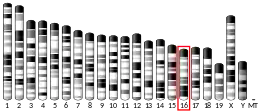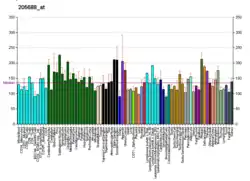TFAP4
Transcription factor AP-4 (activating enhancer binding protein 4), also known as TFAP4, is a protein which in humans is encoded by the TFAP4 gene.[5]
Function
Transcription factor AP4 is a member of the basic helix-loop-helix (bHLH) transcription factors, which bind to the E-box sequence in the promoters of their target genes. AP-4 has been shown to act both as a repressor and an activator for different target genes.
References
- GRCh38: Ensembl release 89: ENSG00000090447 - Ensembl, May 2017
- GRCm38: Ensembl release 89: ENSMUSG00000005718 - Ensembl, May 2017
- "Human PubMed Reference:". National Center for Biotechnology Information, U.S. National Library of Medicine.
- "Mouse PubMed Reference:". National Center for Biotechnology Information, U.S. National Library of Medicine.
- "Entrez Gene: TFAP4 transcription factor AP-4 (activating enhancer binding protein 4)".
Further reading
- Hu YF, Lüscher B, Admon A, et al. (1991). "Transcription factor AP-4 contains multiple dimerization domains that regulate dimer specificity". Genes Dev. 4 (10): 1741–52. doi:10.1101/gad.4.10.1741. PMID 2123466.
- Mermod N, Williams TJ, Tjian R (1988). "Enhancer binding factors AP-4 and AP-1 act in concert to activate SV40 late transcription in vitro". Nature. 332 (6164): 557–61. Bibcode:1988Natur.332..557M. doi:10.1038/332557a0. PMID 2833704. S2CID 4340282.
- Ou SH, Garcia-Martínez LF, Paulssen EJ, Gaynor RB (1994). "Role of flanking E box motifs in human immunodeficiency virus type 1 TATA element function". J. Virol. 68 (11): 7188–99. doi:10.1128/JVI.68.11.7188-7199.1994. PMC 237158. PMID 7933101.
- Lewis TB, Wood S, Michaelis EK, et al. (1996). "Localization of a gene for a glutamate binding subunit of a NMDA receptor (GRINA) to 8q24". Genomics. 32 (1): 131–3. doi:10.1006/geno.1996.0088. PMID 8786101.
- Petersenn S, Rasch AC, Heyens M, Schulte HM (1998). "Structure and regulation of the human growth hormone-releasing hormone receptor gene". Mol. Endocrinol. 12 (2): 233–47. doi:10.1210/mend.12.2.0057. PMID 9482665.
- King-Jones K, Korge G, Lehmann M (1999). "The helix-loop-helix proteins dAP-4 and daughterless bind both in vitro and in vivo to SEBP3 sites required for transcriptional activation of the Drosophila gene Sgs-4". J. Mol. Biol. 291 (1): 71–82. doi:10.1006/jmbi.1999.2963. PMID 10438607.
- Strausberg RL, Feingold EA, Grouse LH, et al. (2003). "Generation and initial analysis of more than 15,000 full-length human and mouse cDNA sequences". Proc. Natl. Acad. Sci. U.S.A. 99 (26): 16899–903. Bibcode:2002PNAS...9916899M. doi:10.1073/pnas.242603899. PMC 139241. PMID 12477932.
- Beausoleil SA, Jedrychowski M, Schwartz D, et al. (2004). "Large-scale characterization of HeLa cell nuclear phosphoproteins". Proc. Natl. Acad. Sci. U.S.A. 101 (33): 12130–5. Bibcode:2004PNAS..10112130B. doi:10.1073/pnas.0404720101. PMC 514446. PMID 15302935.
- Gerhard DS, Wagner L, Feingold EA, et al. (2004). "The Status, Quality, and Expansion of the NIH Full-Length cDNA Project: The Mammalian Gene Collection (MGC)". Genome Res. 14 (10B): 2121–7. doi:10.1101/gr.2596504. PMC 528928. PMID 15489334.
- Martin J, Han C, Gordon LA, et al. (2005). "The sequence and analysis of duplication-rich human chromosome 16" (PDF). Nature. 432 (7020): 988–94. Bibcode:2004Natur.432..988M. doi:10.1038/nature03187. PMID 15616553. S2CID 4362044.
- Olsen JV, Blagoev B, Gnad F, et al. (2006). "Global, in vivo, and site-specific phosphorylation dynamics in signaling networks". Cell. 127 (3): 635–48. doi:10.1016/j.cell.2006.09.026. PMID 17081983.
External links
- TFAP4+protein,+human at the U.S. National Library of Medicine Medical Subject Headings (MeSH)
This article incorporates text from the United States National Library of Medicine, which is in the public domain.
This article is issued from Wikipedia. The text is licensed under Creative Commons - Attribution - Sharealike. Additional terms may apply for the media files.




